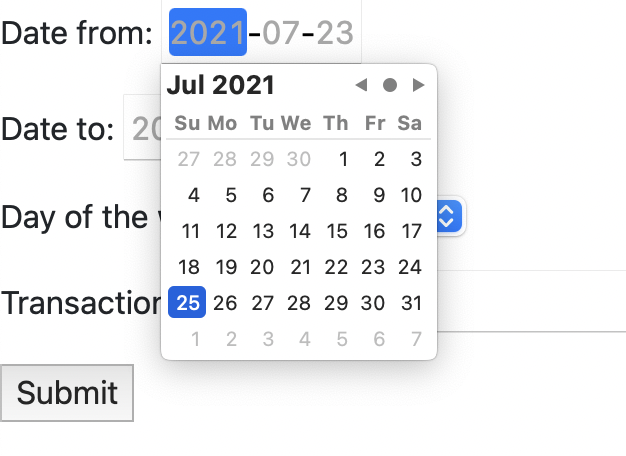Date picker and time picker are a must when you are developing a professional Django application. Using it has 2 main advantages:
- Guarantees that the user will enter the data in the correct format
- Easy to user interface
Date Picker is usually implemented with Javascript in Django, but HTML5 actually comes with a date picker element that can be implemented onto Django forms making it ultra light weight.
1. Create widget.py
We will be creating the date picker as custom widgets in Django. Widgets can be created directly in forms.py. But, I find that it is easier to organize and maintain down the road if they are in a separate widgets.py file.
Widget.py is created in the project folder with forms.py, models.py, etc.
2. Create the Widget
There are 3 possible pickers to choose from:
- Date Picker
- Time Picker (only a controlled input element, no actual graphic selection)
- Date Time Picker
This is an example of the code in widget.py
from django import forms
class DatePickerInput(forms.DateInput):
input_type = 'date'
class TimePickerInput(forms.TimeInput):
input_type = 'time'
class DateTimePickerInput(forms.DateTimeInput):
input_type = 'datetime'
The class can have any name, and they inherit from their respective Inputs. Because it is HTML5 element instead of Javascript, all you need to do to initiate it is by declaring the input_type.
3. Using the Widgets in Django Form
Now that we created the widgets, we move to forms.py and import the widgets we just created.
We can use the widgets in Form or ModelForm.
In Form
from .widgets import DatePickerInput, TimePickerInput, DateTimePickerInput
class ExampleForm(forms.Form):
my_date_field = forms.DateField(widget=DatePickerInput)
my_time_field = forms.TimeField(widget=TimePickerInput)
my_date_time_field = forms.DateTimeField(widget=DateTimePickerInput)In ModelForm
from .widgets import DatePickerInput, TimePickerInput, DateTimePickerInput
class ExampleForm(ModelForm):
class Meta:
model = Example
fields = ['my_date_field', 'my_time_field', 'my_date_time_field']
widgets = {
'my_date_field' : DatePickerInput(),
'my_time_field' : TimePickerInput(),
'my_date_time_field'' : DateTimePickerInput(),
}


That’s it! We have now implemented a DatePicker without Javascript. I hope you enjoyed my first Django article. I will be writing more as I take my Django project further 🙂
I would love to hear if there are any other Html5 elements that can be incorporated into Django like the Date Picker.